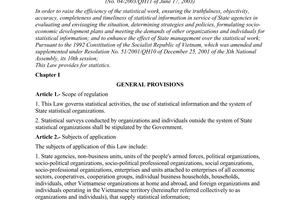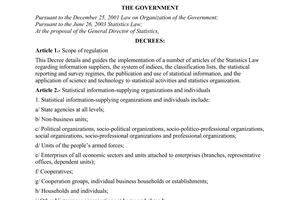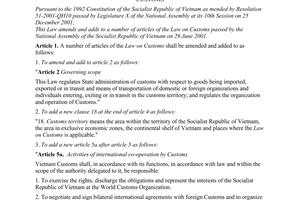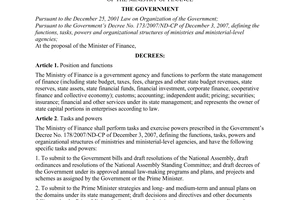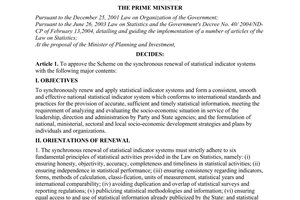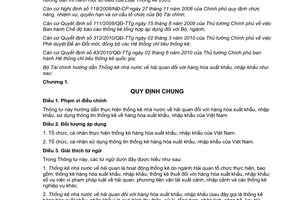Nội dung toàn văn 168/2011/TT-BTC Circular No.168/2011/TT-BTC guiding state customs statistics
|
THE MINISTRY OF FINANCE |
SOCIALIST REPUBLIC OF VIET NAM |
|
No. 168/2011/TT-BTC |
Hanoi, November 21, 2011 |
CIRCULAR
GUIDING STATE CUSTOMS STATISTICS ON IMPORTS AND EXPORTS
Pursuant to June 17, 2003 Statistics Law No. 04/2003/QH11;
Pursuant to June 29, 2001 Customs Law No. 29/2001/QH10 and June 14, 2005 Law No. 42/2005/QH11 amending and supplementing a number of articles of the Customs Law;
Pursuant to the Government's Decree No. 40/2004/ND-CP of February 13, 2004, detailing and guiding the implementation of a number of articles of the 2003 Statistics Law;
Pursuant to the Government's Decree No. 118/2008/ND-CP of November 27, 2008, defining the functions, tasks, powers and organizational structure of the Ministry of Finance;
Pursuant to the Prime Minister's Decision No. 111/2008/QD-TTg of August 15, 2008, promulgating the Regulation on general statistical reporting applicable to ministries and sectors;
Pursuant to the Prime Minister's Decision No. 312/2010/QD-TTg of March 2, 2010, approving the Scheme on renewal and synchronization of systems of statistical indicators;
Pursuant to the Prime Minister's Decision No. 43/2010/QD-TTg of June 2, 2010, promulgating the system of national statistical indicators,
The Ministry of Finance guides state customs statistics on imports and exports as follows:
Chapter I
GENERAL PROVISIONS
Article 1. Scope of regulation
This Circular guides state customs statistics on imports and exports and use of statistical information on imports and exports of Vietnam.
Article 2. Subjects of application
1. Organizations and individuals compiling statistics on imports and exports of Vietnam.
2. Organizations and individuals using statistical information on imports and exports of Vietnam.
Article 3. Interpretation of terms
In this Circular, the terms below are construed as follows:
1. State customs statistics means statistical activities carried out by the customs sector, including statistics on imports and exports; statistics on duties on imports and exports; number of cases of violation of the customs law; means of transport on entry and exit, and other statistical operations.
2. State customs statistics on imports and exports (below referred to as import and export statistics) means the process of collecting, processing, synthesizing, analyzing, publishing, storing, cooperating and exchanging information on the importation and exportation of goods (information on commodity items, headings, unit of calculation, quantity, value, partner country/territory...) of Vietnam, carried out by the General Department of Customs.
The phrases "international merchandise trade statistics" and "foreign merchandise trade statistics" are understood in the same way as the phrase "import and export statistics" referred to in this Circular.
3. Statistical information on imports and exports is products of statistical activity, comprising statistical data and analytical tables of these data.
4. Trade systems are used in import and export statistics for identification of transactions included in or excluded from import and export statistics. Based on the scope of transactions, trade systems can be classified into three different types:
- Special trade system used in import and export statistics, covering goods entering or leaving Vietnam's territory embracing the domestic market and export-processing zones, industrial parks, hi-tech parks, places of export processing or production...
- Expanded special trade system used in import and export statistics, covering goods entering or leaving Vietnam's territory under the special trade system and also special economic-trade zones, border-gate economic zones, special economic zones...
- General trade system used in import and export statistics, covering goods entering or leaving Vietnam's territory under the expanded special trade system and also bonded warehouses, free-tariff areas (commercial and industrial free areas (free ports and warehouses...).
Diagram: Description of trade systems in import and export statistics (see next page)
5. Statistical metadata of imports and exports means a system of data describing statistical data of imports and exports aimed at helping users of statistical information more clearly understand statistical data and analytical tables of statistical information, and compare statistical data of imports and exports of Vietnam with similar statistical data of other countries and territories.
6. Information publication plan means a preset schedule specifying a timetable for publishing statistical information on imports and exports.
Diagram: Description of trade systems in import and export statistics

7. Adjustment of statistical information means the revision and supplementation of published statistical information on imports and exports when there arises more complete and accurate new information or when there are substantial changes in concepts, definitions, classifications and data sources, with a view to ensuring the authenticity and comparability of statistical information over different periods.
Article 4. Principles of compilation of import and export statistics
Statistics on imports and exports must be compiled on the following fundamental principles:
1. Assurance of completeness, timeliness and accuracy of statistical information on imports and exports.
2. Assurance of uniformity of statistical methodology, systems of indicators and reporting forms and regulations on import and export statistics nationwide.
3. Assurance of integrity, transparency, independence, non-duplication and non-overlap in the process of compiling import and export statistics.
4. Assurance of comparability of statistics on bilateral imports and exports of Vietnam with similar statistical data of other countries and territories.
Article 5. Prohibited acts in import and export statistics export statistics
1. Failing to collect, process, synthesize and report statistical information on imports and exports, obstructing or improperly or inadequately carrying out these activities.
2. Intentionally distorting statistical information and publishing untruthful statistical information.
3. Disclosing statistical information classified as state secrets to unauthorized organizations or persons for use for improper purposes.
4. Disclosing specific statistical information on imports and exports associated with specific names and addresses of individual organizations or persons without the consent of such organizations or persons to unauthorized organizations or persons for use for improper purposes.
5. Other acts in violation of the statistics law.
Chapter II
METHODS OF COMPILING IMPORT AND EXPORT STATISTICS
Article 6. Trade systems in import and
Import and export statistics of Vietnam under the general trade system shall be compiled by the General Department of Customs.
In some specific cases to serve research, comparison and analysis, import and export statistics of Vietnam may be compiled under the special trade system or the expanded special trade system.
Article 7. Scope of import and export statistics
1. All goods taken out of Vietnam's customs territory (exported) or brought into Vietnam's customs territory (imported) which reduce or increase Vietnam's material resources fall within the scope of statistics. Those goods temporarily brought into or taken out of Vietnam's customs territory which do not increase or reduce Vietnam's material resources do not fall within the scope of statistics.
2. Exports are all goods of domestic origin and re-exported goods sent abroad, reducing Vietnam's material resources, in which:
a/ Goods of domestic origin are those exploited, produced or processed domestically under Vietnam's regulations on goods origin;
b/ Re-exported goods are those imported by Vietnam then re-exported in the same state as previously imported or after being simply processed, preserved and repackaged without changing their basic characteristics.
3. Imports are all goods of foreign origin and re-imported goods brought into the country, increasing Vietnam's material resources, in which:
a/ Goods of foreign origin are those exploited, produced or processed abroad under Vietnam's regulations on goods origin;
b/ Re-imported goods are those exported by Vietnam then re-imported in the same state as previously exported or after being simply processed, preserved and repackaged without changing their basic characteristics.
Article 8. Goods to be included in import and export statistics of Vietnam
1. Goods traded or exchanged between Vietnamese and foreign organizations and individuals in the following forms:
a/ Goods imported or exported under goods purchase and sale contracts;
b/ Goods imported or exported in the form of importing materials for export production;
c/ Goods imported or exported to perform processing contracts concluded with foreign countries;
d/ Goods imported or exported for investment projects;
e/ Goods traded in the form of temporary import for re-export or temporary export for re-import (excluding those stated in Article 9 of this Circular);
f/ Goods brought from abroad into bonded warehouses and vice versa;
g/ Goods traded or bartered among border residents; goods imported or exported across the border without purchase and sale contracts;
h/ Goods of persons on entry or exit in excess of the prescribed personal baggage allowances which are dutiable;
i/ Good imported or exported in the form of loan or aid of Vietnamese and foreign governments or non-governmental organizations;
j/ Goods imported or exported which are movables of organizations or persons entering or leaving Vietnam.
2. Goods in some specific cases:
a/ Non-monetary gold: gold bars, bullions, powder, flakes... imported or exported by enterprises or commercial banks (excluding banks authorized by the State Bank) for commercial, processing, fashioning... purposes in accordance with law;
b/ Unissued banknotes, coins and securities not for circulation or not in circulation; collections of banknotes and coins;
c/ Returned goods;
d/ Goods under financial lease contracts whereby lessees assume benefits, responsibilities, risks... in relation to goods. For contracts containing unclear contents on these issues, the lease term of 12 months or longer will be based on;
e/ Gifts and presents of organizations and individuals;
f/ Goods sent abroad for display at exhibitions and fairs; commercial samples; educational and training materials; breeding animals; animals and instruments for circus and art performances, sports competitions; transporting vehicles which are then sold or donated abroad, and foreign goods imported into Vietnam for the above purposes but then not re-exported;
g/ Magnetic tapes and discs, CD-ROMs and other media recorded with sounds, images or data or computer software for general use purposes or normal commercial purposes (excluding those produced upon request or order);
h/ Electricity, water, petrol, crude oil and gas;
i/ Goods imported or exported via e-commerce: The exchange of information, placement of orders, conclusion of commercial contracts and payment with foreign countries are carried out through the Internet but goods are brought into or taken out of Vietnam's territory and go through normal customs procedures;
j/ Goods bartered among countries and territories without payment;
k/ Goods dispatched or received by post or express delivery service;
l/ Goods supplied to aircraft, vessels and other vehicles in international trips.
Article 9. Goods to be excluded from import and export statistics of Vietnam
1. Goods crossing Vietnam's territory simply for transportation, including goods in transit and transshipped goods.
2. Goods temporarily imported for re-export or temporarily exported for re-import within given periods of time, such as goods for display at exhibitions and fairs; commercial samples; educational and training materials; breeding animals; animals and instruments for circus and art performances, sports competitions; transporting means which enter then leave Vietnam and vice versa.
3. Goods bought or sold at duty-free shops.
4. Goods brought from the domestic market into bonded warehouses pending export. Goods brought from bonded warehouses into the domestic market.
5. Goods exported or imported on spot.
6. Goods transferred among industrial parks, export-processing zones, hi-tech parks and economic zones and between these parks or zones and the domestic market (because they are already included in statistics when they enter or leave the customs territory).
7. Goods in some special cases:
a/ Monetary gold: gold imported and exported by the Slate Bank of Vietnam for national monetary reserve and balance (monetary gold under sub-heading 7108.20 in the import tariff);
b/ Coins in circulation, and issued banknotes and checks in circulation;
c/ Governmental goods delivered to or received from diplomatic representative missions and embassies;
d/ Goods under operational lease or charter contracts of a term of under 12 months (aircraft, vessel, machinery, equipment...);
e/ Goods being machinery and equipment temporarily imported for re-export or temporarily exported for re-import for work construction and investment projects;
f/ Goods used as carrying means or tools, such as empty containers, barrels, bottles... solely for goods carriage purposes;
g/ Digital products and contents exchanged in e-commerce (e.g. movies, music and software applications... downloaded or uploaded);
h/ Goods brought into or taken out of Vietnam's customs territory for repair or maintenance which does not change the origin of such goods;
i/ Goods illegally entering or leaving Vietnam's customs territory.
Article 10. Sources of import and export statistics
1. Import and export statistics of Vietnam shall be collected from the following sources:
a/ Import and export declaration forms; documents enclosed with customs dossiers, including bills of lading, value declarations, certificates of origin and other related documents;
b/ Import and export statistical reports of provincial-level Customs Departments, district-level Customs Departments and other units within the customs sector;
c/ Other additional information sources.
2. When converting data to serve statistical purposes (i.e. converting statistical values, quantities, units of calculation, currency used in statistics...), statistics-compiling organizations and individuals may not change customs operation information.
Article 11. Time of import and export statistics
1. Time of statistics is the time customs offices accept registration of customs declaration forms.
2. For customs declaration forms registered once under which importations or exportations are multiple, the time of statistics is the time of registration of such declaration forms. Should arise any change compared to the registered declaration form in the course of importation or exportation, statistics will be adjusted based on the actual importation or exportation.
3. For cases of correction or adjustment of declaration forms or supplementation of customs dossiers during operational processes, the time of statistics is the time of declaration registration. Any changed contents shall be updated in operational information technology systems and relevant statistics shall be adjusted.
4. Replaced or cancelled declaration forms shall be excluded from previously compiled statistics.
5. Changed information referred to in Clauses 2, 3 and 4 of this Article shall be reflected in cumulative data of the current period and reported statistics of the period of adjustment.
Article 12. Classifications of goods used in statistics
1. Imports and exports in Vietnam's statistics are classified according to the current export tariff and import tariffs.
2. The Standard International Trade Classifications (SITC) and other classifications recommended by the United Nations Statistics Division are used for economic analysis and other statistical purposes.
Article 13. Statistical values of imports and exports
1. Statistical value of imports or exports is a value developed by statistics compilers for statistical synthesis and reporting purposes on the following principles:
a/ The statistical value of imports is their CIF value (i.e. the value based on CIF or equivalent delivery conditions);
b/ The statistical value of exports is their FOB value (i.e. the value calculated based on FOB or equivalent delivery conditions).
On a case-by-case basis, the statistical value of imports or exports shall be developed under Clauses 2, 3 and 4 of this Article.
2. Statistical value of dutiable goods:
a/ The statistical value is the dutiable value, if the goods have a value based on FOB or equivalent delivery conditions (for exports) or a value based on CIF or equivalent delivery conditions (for imports);
b/ For goods transported by land across the land border, the statistical value of imports or exports shall be calculated based on their DAF or DAP value.
3. For goods which are not liable to duty, are duty-free or exempted from duty, their statistical value is that declared by customs declarants on the following principles:
a/ For imports, the statistical value is based on their selling prices at the border gate of importation (FOB, DAF or DAP price);
b/ For exports, the statistical value is based on their actual selling prices at the first border gate of exportation (CIF, DAF or DAP price).
4. In case the statistical value of goods cannot be determined under Clause 2 or 3 of this Article, it may be converted into the value based on FOB conditions (for exports) or based on CIF conditions (for imports). Statistics compilers shall carry out the conversion on the basis of information in customs dossiers and relevant information.
5. Determination of statistical values in specific cases:
a/ For once-registered customs declaration forms for multiple import or export, the statistical value is the actual value of goods upon importation or exportation;
b/ For goods allowed for filling temporarily calculated prices in customs declaration forms, their statistical value must be adjusted when their official prices are available;
c/ For unissued banknotes, coins and valuable papers not in circulation, their statistical value is their production expenses (not their par value);
d/ For magnetic tapes and discs, CD-ROMs and other media already recorded with sounds or images, computer data or software imported or exported for commercial purpose, the statistical value is their total transaction value (not only the value of media containing no information), minus expenses for copyright licensing, if separately calculated;
e/ For processed goods for export, their statistical value is the total value of components of products according to FOB, DAF or DAP prices. If it is impossible to calculate their value according to these prices, it shall be calculated according to the following formula:
Price of a unit of processed goods for export = the total value of imported materials of a product + other expenses (if any) of a product + the pricing cost of a product;
f/ For goods under financial lease contracts, their statistical value is their value upon sale, excluding accompanying services provided under the contracts, such as training and maintenance expenses and financial charges;
g/ For goods which accompany services, their statistical value shall be determined based on their FOB prices (for exports) or CIF prices (for imports), exclusive of service charges;
h/ For transactions for which value declaration is not required (for example, goods barter, humanitarian aid goods...), the value of goods in statistics will be determined according to the principle of customs valuation of imports and exports of Vietnam and Clauses 2,3 and 4 of this Article.
Article 14. Units of calculation in statistics
1. Units of calculation in statistics on imports and exports are uniformly used according to regulations applicable to customs declaration forms.
2. When converting other units of calculation of quantities for statistical purposes, it is necessary to base on gross weight, net weight, average price unit and other items on declaration forms and related documents.
Article 15. Countries and territories being trading partners in statistics
2. For exports of Vietnam: countries or territories of final destination determined at the time of exportation, not counting those through which the goods transit.
2. For imports into Vietnam: countries and territories in which such goods originate under origin regulations of Vietnam.
3. In addition, countries and territories delivering goods (from which the goods are sent to Vietnam) are also regarded as trading partners to serve statistical and other analytical purposes.
4. Country and territory codes in import and export statistics comply with the international standard code system ISO 3166.
Article 16. Currencies and exchange rates used in statistics
1. The currencies used in import and export statistics of Vietnam are Vietnam dong and US dollar.
2. Other foreign currencies shall be converted into Vietnam dong or US dollar in import and export statistics at the average transaction exchange rates on the interbank foreign currency market announced by the State Bank at the time of declaration registration.
Article 17. Application of information technology in import and export statistics
1. The General Department of Customs shall plan, research, develop and apply information technology applications in import and export statistics uniformly nationwide according to regulations.
2. Provincial-level Customs Departments shall develop information technology applications in statistics in accordance with this Circular.
Chapter III
COLLECTION, INVESTIGATION, PROCESSING SUMMARIZATION, ANALYSIS, DISSEMINATION AND STORAGE OF STATISTICAL INFORMATION ON IMPORTS AND EXPORTS
Article 18. Collection and processing of statistical information on imports and exports
Statistical information on imports and exports shall be collected and processed in the stages of the customs operation process.
1. District-level Customs Departments shall:
a/ Check the completeness of data on customs declarations and related documents and the accuracy of information in the stages of the customs operation process;
b/ Receive, check, correct and report on incorrect information and data on declaration forms and related documents.
2. Provincial-level Customs Departments shall:
a/ Check the adequacy of the quantity of declaration forms and related documents and the accuracy of information in the stages of the customs operation process in the electronic database;
b/ Check and report on incorrect information at different levels.
3. The General Department of Customs shall:
a/ Check the adequacy of the quantity of declaration forms and related documents and the accuracy of information in the stages of the customs operation process in the electronic database nationwide;
b/ Check, detect and guide customs units at all levels to correct errors in the process of compiling import and export statistics;
c/ Collect other information outside customs dossiers.
Article 19- Statistical investigations
1. In case of necessity, the Ministry of Finance shall issue decisions on statistical investigations with regard to organizations and individuals engaged in import and export activities.
2. Organizations and individuals subject to statistical investigation shall fully discharge their responsibilities. Statistical investigations shall be conducted strictly according to professional methods provided in the Statistics Law.
Article 20. Import and -export statistical reporting
1. The General Department of Customs shall:
a/ Report statistical information on imports and exports to Party and State agencies according to prescribed forms and make other irregular statistical reports.
b/ Coordinate with ministries and sectors in periodically modifying and supplementing statistical forms of imports and exports to meet requirements of users.
2. Provincial-level Customs Departments and district-level Customs Departments shall report statistical information on imports and exports to the General Department of Customs upon request.
3. Heads of units within the customs sector and organizations and persons making and signing statistical reports shall take responsibility for the accuracy, completeness and timeliness of statistical information within the scope of their respective functions and tasks.
Article 21. Analysis and forecast of statistical information on imports and exports
1. The General Department of Customs shall research, develop and conduct analyses and forecasts about import and export statistics.
2. Analyses of import and export statistics must truthfully and objectively reflect the situation of import and export.
Article 22. Adjustment of statistical information
1, The General Department of Customs shall adjust statistical information on imports and exports in the following forms:
a/ Regular adjustment: periodically adjust reported and published information when supplementing lacking information, update changed information in the stages of the customs operation process and correcting inaccurate statistical information. There are three types of regular adjustment:
- Current adjustment: adjustments made at the subsequent reporting period for 15-day and monthly reporting periods. Adjusted data shall be reflected in accumulative data;
- Adjustment after first six months: adjustments made within 60 days after completing June reports for published periodical and monthly reports;
- Annual adjustment: adjustments made within 90 days after completing annual reports for published periodical, monthly and annual reports. Information, once annually adjusted, will become official.
Data adjusted after first six months and annually shall be reflected in reported data and accumulative data of each period, month and year.
b/ Irregular adjustment: adjustments to data made when there are significant changes in concepts, definitions, classifications and data sources. Adjusted data may be of one year or many years to ensure their comparability.
2. The General Department of Customs shall inform reasons for adjustment to data users to prove the validity of adjusted data which are included in plans on publication of statistical information on imports and exports.
Article 23. Publication of statistical information
1. The General Department of Customs shall formulate and announce plans on publication of import and export information and publish such information to users according to the plans.
2. Published statistical information on imports and exports is general statistical information.
3. Types of published information include estimated, preliminary, adjusted and official information.
4. The time of publishing applicable to each type of information:
a/ Estimated information: to be published on the 25th every month;
b/ Preliminary information: to be published within 5 days after sending periodical and monthly reports;
c/ Adjusted information: The time of publishing may vary between regularly and irregularly adjusted information.
- The General Department of Customs shall publish regularly adjusted information at different times corresponding to three types of regular adjustment:
+ Current adjustment: adjusted information shall be published in the subsequent reporting period;
+ Adjustment after first six months: adjusted information shall be published before October 1 of the current year;
+ Annual adjustment: adjusted information shall be published before May 1 of the subsequent year.
- The General Department of Customs shall publish irregularly adjusted information immediately after completing the adjustment.
5. Information shall be published electronically or in paper form.
Article 24. Assurance of quality of statistical information on imports and exports
The General Department of Customs shall assure quality of statistical information on imports and exports according to Vietnam's reality and recommendations of regional and international organizations, specifically:
1. To develop a framework to assure statistical information quality, including methods of measurement and indicators for quality assurance.
2. To develop a feedback mechanism to absorb opinions of users of statistical information on imports and exports.
3. To make annual reports on quality assurance of statistical information on imports and exports.
Article 25. Megadata on imports and exports
The General Department of Customs shall build and operate a megadata of import and export statistics, consisting of information describing statistical data on imports and exports of Vietnam, specifically:
a/ Legal documents and relevant guiding documents;
b/ Concepts, definitions and descriptions of methodology;
c/ Processes of collection and processing information; data sources, databases:
d/ Lists of standard statistical tables; statistical forms, explanations on relevant information and table-filling instructions; statistical products;
e/ Regulations and guidelines on the publication, adjustment and assurance of quality and confidentiality of information;
f/ Documents and materials of regional and international organizations concerning import and export statistics;
g/ Information on statistics users.
Article 26. Cooperation in, provision and exchange of statistical information on imports and exports with partner countries and regional and international organizations
1. The General Department of Customs shall:
a/ Provide and exchange statistical information on imports and exports with partner countries and regional and international organizations within the framework of bilateral and multilateral cooperation agreements and commitments and in accordance with Vietnamese law;
b/ Formulate plans and carry out technical cooperation, exchange information and compare statistical data on imports and exports with partner countries, and regional and international organizations.
2. The cooperation in, provision and exchange of information under this Article must be carried out on the principle of consistency with published indicators.
Article 27. Cooperation in, provision and exchange of information with state management agencies and other entities
1. The cooperation in, and provision and exchange of statistical information on imports and exports between the General Department of Customs and state management agencies and other entities (research agencies, business associations, mass media agencies...) shall be carried out in accordance with relevant laws and on the basis of information cooperation, provision and exchange documents signed between competent authorities of the parties.
2. In case of provision and exchange of information outside the scope stated in the documents mentioned in Clause 1 of this Article, approval of competent authorities is required.
3. Provided and exchanged statistical information on imports and exports is general statistical information. In special cases, to serve state management, the General Department of Customs may provide detailed statistical information.
Article 28. Information storage
1. The General Department of Customs shall build and manage a store of data on imports and exports.
2. The time limit for preserving reports and databases of import and export statistics complies with applicable laws.
Article 29. Confidentiality of statistical information
1. Confidential statistical information includes statistical information on specific imports and exports associated with specific names and addresses of individual organizations or persons and information classified as state secrets (below referred to as confidential information in import and export statistics).
2. The preservation, storage, publication and provision of and reporting on statistical information on imports and exports on the list of state secrets comply with the Ordinance on Protection of State Secrets and guiding documents.
3. The General Department of Customs, provincial-level Customs Departments, district-level Customs Departments and persons involved in compiling import and export statistics, and users of import and export statistics of Vietnam shall:
a/ Not disclose confidential information in import and export statistics;
b/ When publishing information on imports and exports, assure that confidential information in import and export statistics not be revealed;
c/ Assure security of confidential information in import and export statistics. In case of providing confidential information in import and export statistics, strictly observe applicable current laws.
Chapter IV
RESPONSIBILITIES AND POWERS OF ORGANIZATIONS AND INDIVIDUALS COMPILING STATISTICS AND USING STATISTICAL INFORMATION ON IMPORTS AND EXPORTS
Article 30. System of customs organizations in charge of import and export statistics
1. The system of customs organizations in charge of import and export statistics consists of:
a/ At the General Department of Customs: The Information Technology and Customs Statistics Department;
b/ At provincial-level Customs Departments: Data and Information Technology Centers and customs officers performing statistical work at functional units of these departments;
c/ At district-level Customs Departments: customs officers involved in different steps of the customs professional process and statistical works.
2. Customs officers performing statistics work referred to at Points b and c, Clause 1 of this Article may work on a full-time or part-time basis.
Article 31. Responsibilities and powers of units within the customs system of import and export statistics
1. Responsibilities and powers of the General Department of Customs:
a/ To organize and develop statistical processes; to guide and examine provincial-level Customs Departments in performing statistics work uniformly nationwide;
b/ To issue regulations on the system of forms and reports on import and export statistics applicable in the entire customs sector;
c/ To develop, manage, operate, store and exploit the database of imports and exports for statistical purposes;
d/ To collect, process, analyze, forecast, provide, report and publish statistical data to users in accordance with law;
e/ To organize and conduct statistical investigations when necessary;
f/ To publish the Directory of Customs Statistics on Imports and Exports of Vietnam;
g/ To request organizations and individuals to send reports to provide information for compiling import and export statistics;
h/ To cooperate on and exchange statistical information on imports and exports with domestic and foreign organizations in accordance with law;
i/ To train, retrain and develop human resources performing the work of compiling import and export statistics.
2. Responsibilities and powers of provincial-level Customs Departments:
a/ To perform statistical work under the guidance of the General Department of Customs;
b/ To guide and examine statistical work on imports and exports by district-level Customs Departments and attached units;
c/ To provide and report on statistical information on imports and exports to organizations within their respective localities for local state management purposes according to regulations.
3. Responsibilities and powers of district-level Customs Departments:
To perform statistical work under the guidance of the General Department of Customs and provincial-level Customs Departments.
Article 32. Responsibilities and powers of organizations and individuals using statistical information on imports and exports
1. Users of statistical information on imports and exports of the General Department of Customs shall comply with the following provisions:
a/ Information classified as state secrets and specific statistical information associated with specific names and addresses of individual organizations or persons must only serve state management work. Use of such information must comply with current laws on confidentiality of information;
b/ Statistical data must not be distorted for personal purposes;
c/ When using statistical information, to ensure the truthfulness of information and quote the General Department of Customs as its source:
d/ Not to use statistical information on imports and exports in activities detrimental to the interests of the country and information providers.
2. Users of statistical information on imports and exports have the following powers:
a/ All organizations and individuals are equal and provided with favorable conditions in accessing and using statistical information on imports and exports published by the General Department of Customs;
b/ To express inquiries concerning statistical information on imports and exports already reported, provided or published.
3. The responsibilities and powers of organizations and individuals in exploiting statistical information on imports and exports comply with regulations and instructions on the use of systems of statistical information on imports and exports.
Chapter V
ORGANIZATION OF IMPLEMENTATION
Article 33. Implementation responsibilities
1. The General Department of Customs shall, in pursuance to this Circular, issue guidelines on and perform and evaluate the work of import and export statistics.
2. Units under the Ministry of Finance shall coordinate with the General Department of Customs in implementing this Circular.
3. Provincial-level Customs Departments shall guide and organize statistical work each of their attached units according to this Circular and the guidance of the General Department of Customs.
4. In the course of implementation of this Circular, if finding any regulations which are problematic or no longer suitable to reality, heads of units and individuals shall report them to the Ministry of Finance (the General Department of Customs) for consideration and appropriate revision.
Article 34. Handling of violations
Violators of this Circular shall, depending on the nature and seriousness of their violations, not be provided with information, be disciplined or sanctioned under regulations.
Article 35. Effect
This Circular takes effect on January 1, 2012, replacing the Minister of Finance's Decision No. 124/2003/QD-BTC of August 1, 2003.-
|
|
FOR THE MINISTER OF FINANCE |

